Powell speech takes center stage in Tuesday’s economic events
Introduction & Market Context
Norse Atlantic ASA (OB:NORSE) presented its Q1 2025 financial results on May 21, 2025, highlighting substantial year-over-year improvements across key operational and financial metrics. The low-cost long-haul carrier reported a record 95% load factor and significantly narrowed losses compared to the same period last year, continuing the positive momentum seen in late 2024.
The airline’s stock has shown volatility in recent months, trading at 6.57 NOK as of May 20, 2025, well below its 52-week high of 11.34 NOK but significantly above its 52-week low of 1.50 NOK. The company’s market capitalization remains modest at approximately $48.8 million, reflecting ongoing investor caution despite operational improvements.
Quarterly Performance Highlights
Norse Atlantic reported impressive operational metrics for Q1 2025, with a record 95% load factor representing a 22 percentage point increase from Q1 2024. The airline transported 304,588 passengers, a 51% year-over-year increase, while operating 1,052 flights compared to 862 in the same period last year.
As shown in the following chart summarizing the Q1 2025 headlines, revenue reached $125.3 million, compared to $78.2 million in Q1 2024, while EBITDAR improved to $15.0 million from negative $27.4 million:
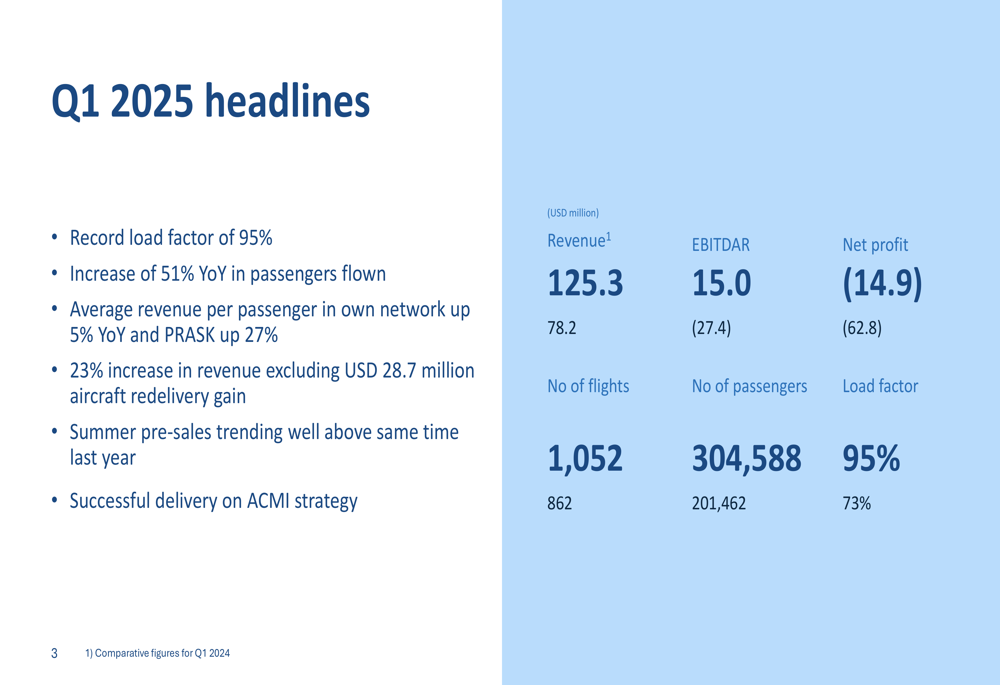
The company’s net loss narrowed significantly to $14.9 million, compared to a $62.8 million loss in Q1 2024. However, it’s important to note that Q1 2025 revenue includes a $28.7 million non-recurring accounting gain from redelivered aircraft, with the actual cash effect recognized in 2024. Excluding this gain, underlying revenue still grew by 23% year-over-year.
The following chart illustrates the company’s world-leading load factor and strong passenger growth:
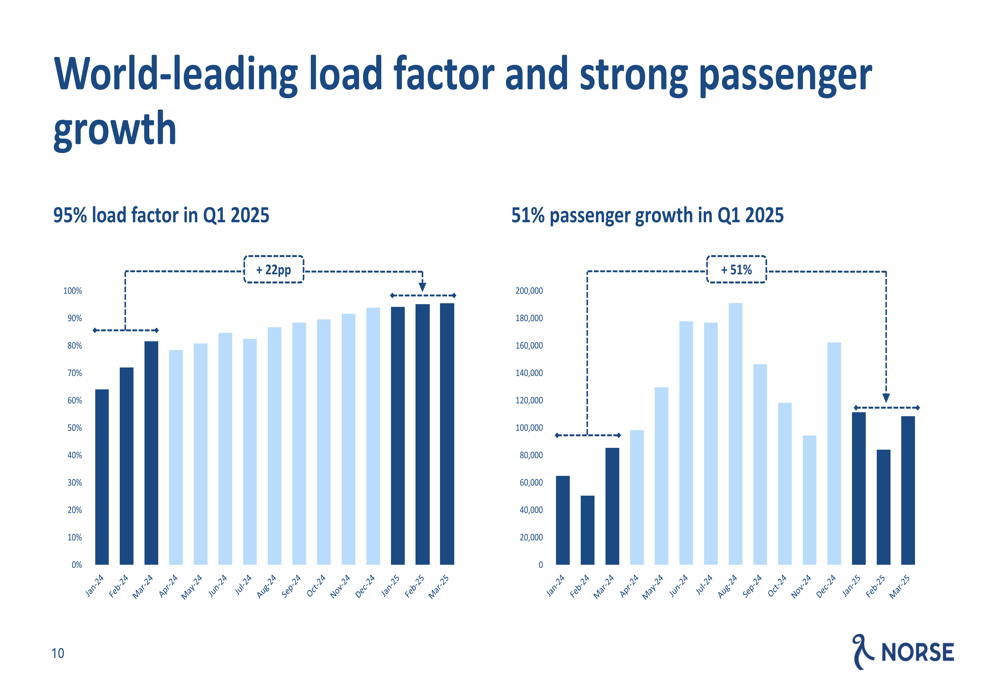
Revenue per passenger increased by 5% year-over-year to $339, with the average airfare at $270 and ancillary revenue at $69 per passenger in Q1 2025:
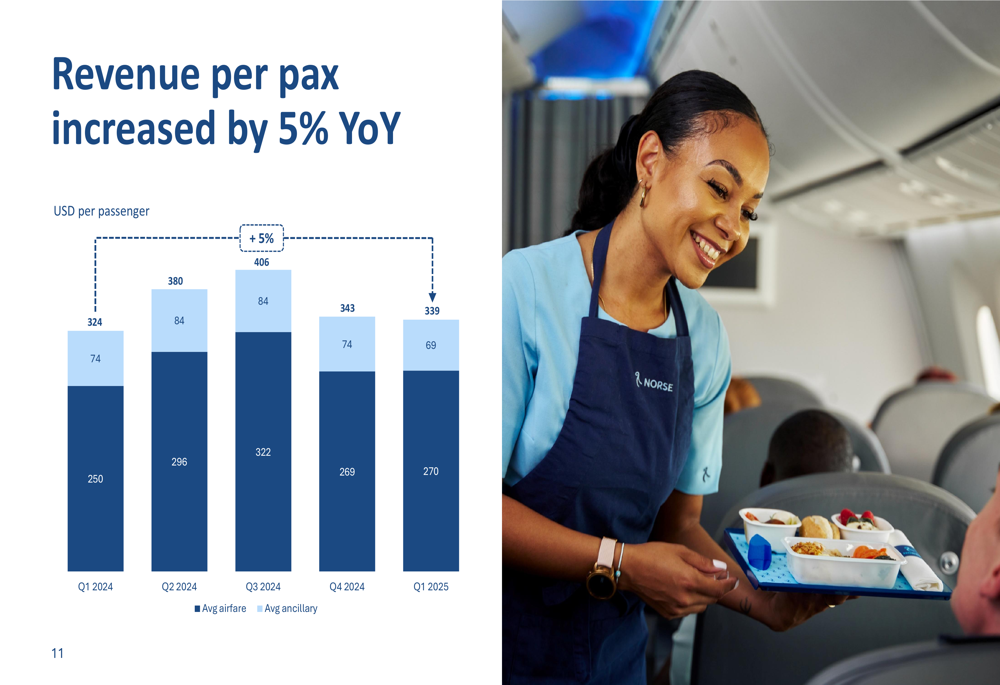
Strategic Initiatives
Norse Atlantic is executing a strategic pivot toward long-term charters and ACMI (Aircraft, Crew, Maintenance, and Insurance) contracts to improve financial predictability and reduce market risk. The company has secured firm contracts with IndiGo for six aircraft, which will secure profitability on approximately 50% of its fleet.
The following chart illustrates how Norse Atlantic is gradually shifting capacity from its own network to charter/ACMI operations:

This strategic shift began in March 2025 when the first aircraft commenced ACMI operations with IndiGo after signing a contract in February. Three additional aircraft were signed in Q1 for second-half 2025 start-up, and two more were signed in May for start-up by January 2026 at the latest.
The company is also implementing significant cost-efficiency initiatives, targeting a 50% reduction in SG&A expenses and improving crew utilization. These efforts have already yielded results, as shown in the following chart of CASK (Cost per Available Seat Kilometer) excluding fuel:
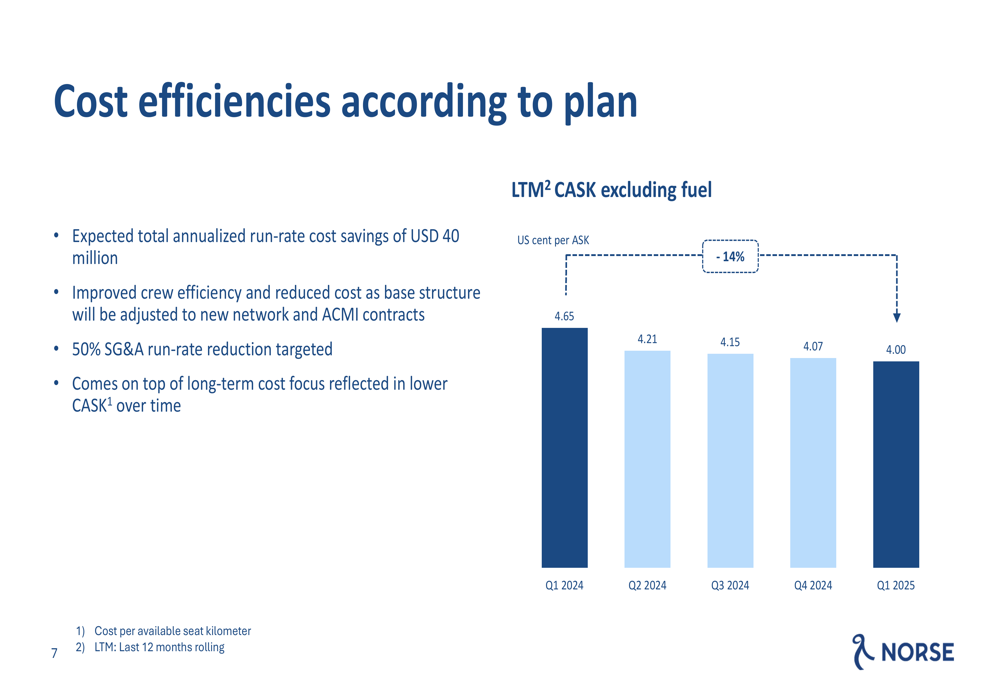
The chart demonstrates a 14% reduction in CASK excluding fuel between Q1 2024 and Q1 2025, from 4.65 to 4.00 US cents per ASK. This improvement reflects the company’s focus on operational efficiency and cost control.
Detailed Financial Analysis
Norse Atlantic’s income statement shows significant improvements across key metrics. Revenue increased by 60% year-over-year to $125.3 million, while EBITDAR turned positive at $15.0 million compared to negative $27.4 million in Q1 2024:

The company also reported positive cash flow from operations of $30.05 million in Q1 2025, compared to $3.15 million in Q1 2024. End-of-quarter cash stood at $25 million, up from $23 million at year-end 2024:
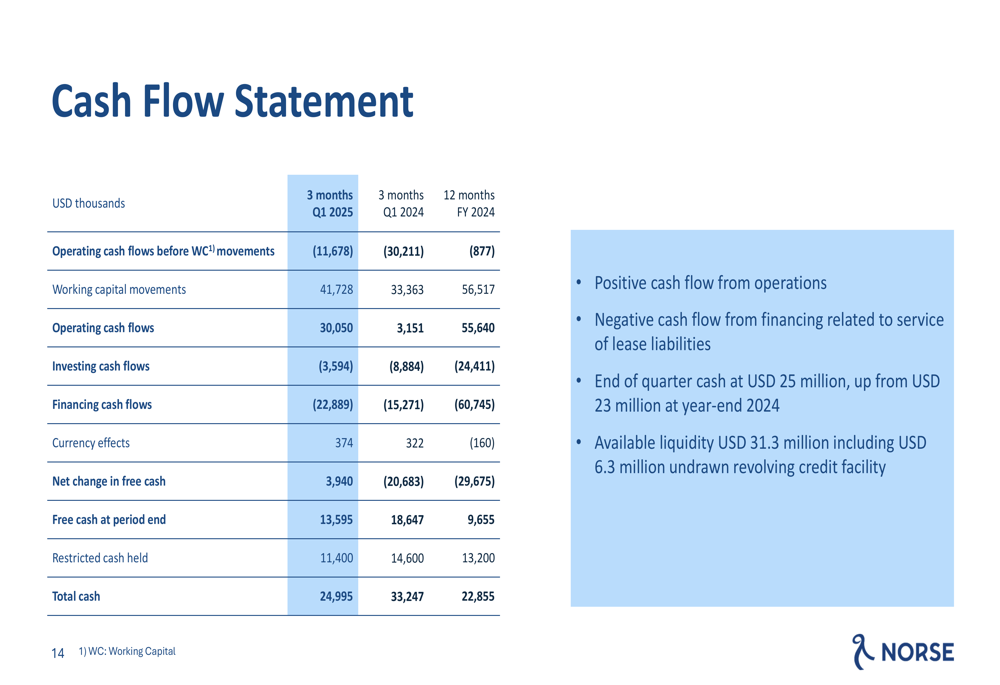
The following chart shows the positive trends in key value drivers, including LTM (Last Twelve Months) revenue, EBITDAR, and cash flow from operations:
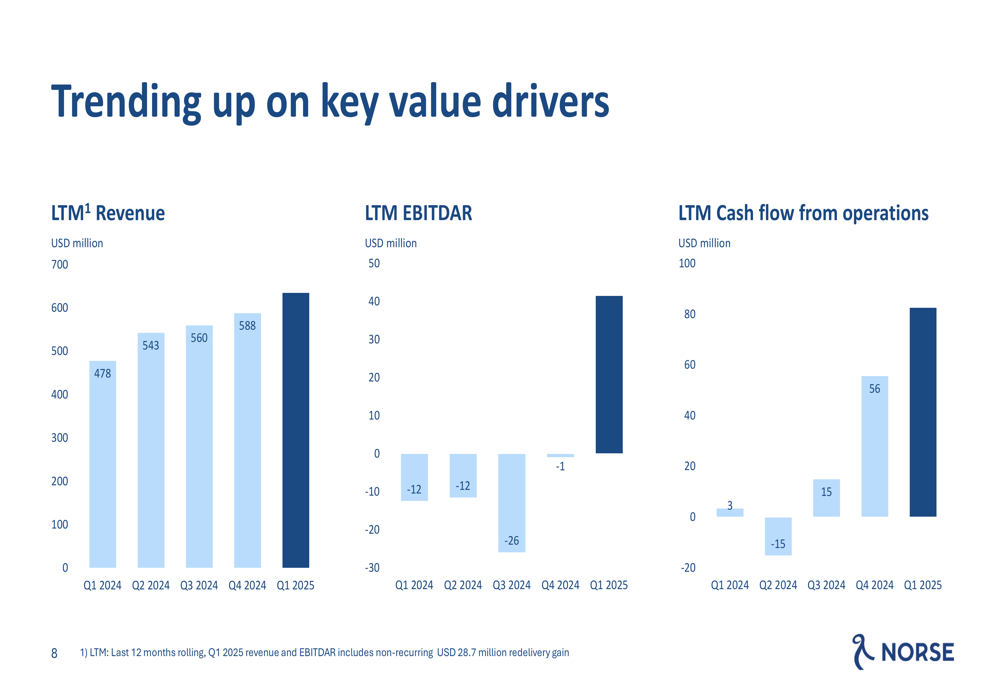
Norse Atlantic has also achieved significant improvements in both PRASK (Passenger Revenue per Available Seat Kilometer) and CASK (Cost per Available Seat Kilometer). PRASK increased by 27% year-over-year, while CASK decreased by 10%:

Forward-Looking Statements
Norse Atlantic’s booking trends for the remainder of 2025 appear promising, with significant improvements in both load factor and PRASK compared to 2024. The following chart shows these positive trends:
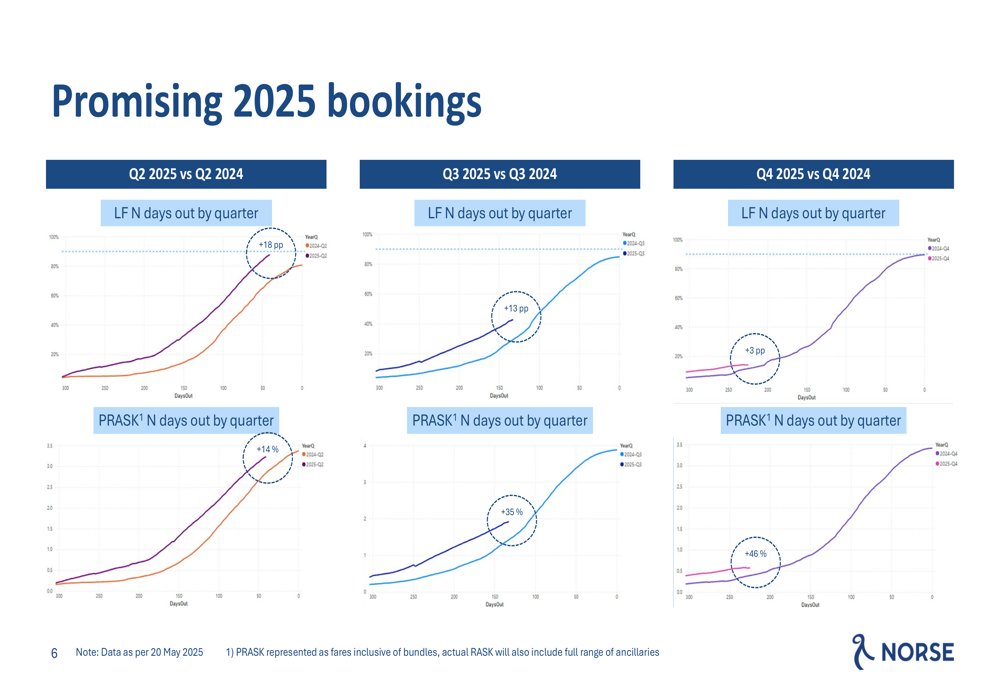
For Q2 2025, the company is seeing a load factor 18 percentage points higher and PRASK 14% higher than the same period last year. Q3 2025 shows even stronger PRASK improvement at 35% higher than Q3 2024, with a 13 percentage point increase in load factor. Q4 2025 is trending toward a 46% increase in PRASK and a 3 percentage point increase in load factor.
These forward-looking indicators, combined with the strategic shift toward ACMI contracts and ongoing cost-efficiency initiatives, support management’s aim to deliver full-year profitability in 2025. This would mark a significant milestone for Norse Atlantic, which has been working toward sustainable profitability since its inception.
CEO Bjorn Thorlassen had previously expressed confidence in the company’s turnaround during the Q4 2024 earnings call, stating, "We have definitely turned the tide in many ways." The Q1 2025 results appear to validate this optimism, showing continued improvement in key operational and financial metrics.
While challenges remain, including the company’s negative equity position of $225.4 million and significant lease liabilities, Norse Atlantic’s strategic pivot and operational improvements suggest a potential path toward sustainable profitability in the competitive long-haul airline market.
Full presentation:
This article was generated with the support of AI and reviewed by an editor. For more information see our T&C.
